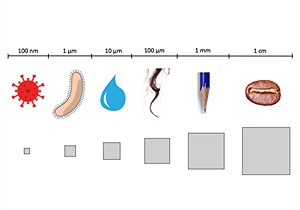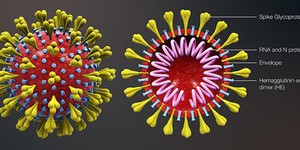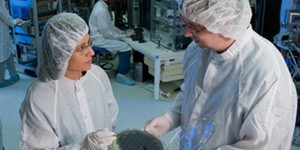Summary
This activity was inspired by "The Science of Microbes, Comparing Sizes of Microorganisms," activity from the Center for Educational Outreach at Baylor College of Medicine
Introduction
Have you ever seen a real virus? Probably not—they are so tiny that it is impossible to see them with your naked eyes. But how big or small are viruses really? The coronavirus Sars-Cov-2, which causes COVID-19, is about 120 nanometers in size. One nanometer is equal to one billionth of a meter! How many of these tiny coronaviruses do you think can you line up inside a pencil dot? In this activity, you will find out by creating a scale model that allows you to compare the size of many different small objects.
Materials
- Meterstick or measuring tape
- Yarn or string (at least 12 m long); thin yarn or yarn with a medium thickness works best.
- Scissors
- Paper
- Pencil and pencil sharpener or a 1-mm mechanical pencil
- Tape
- Permanent marker
- Optional: Magnifying glass
- Optional, if you measure in two dimensions: Large space (10 m2) either outside (driveway, yard, park) or indoors (wall, floor)
- Optional, if you measure in two dimensions: Painter's tape, additional yarn or string, or chalk
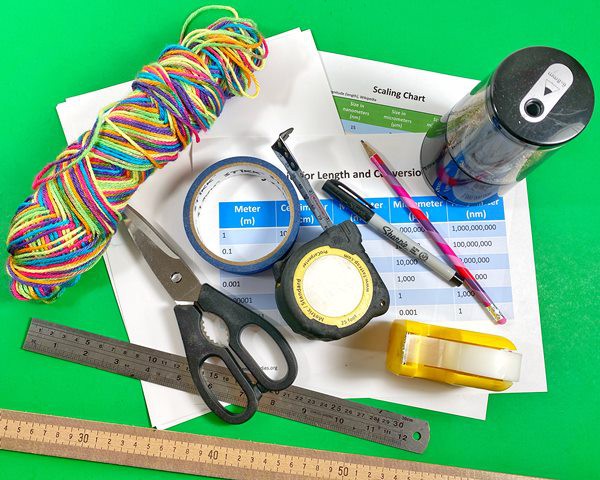 Image Credit: Svenja Lohner, Science Buddies / Science Buddies
Image Credit: Svenja Lohner, Science Buddies / Science Buddies
Prep Work
- Review this Units and Conversion Table to familiarize yourself with the units of measurements for length. In this activity we will be using the International Systems of Units (SI).
- Look at the markings of your meterstick and the measuring tape. If you do not know yet, find out what the lines on the meterstick or measuring tape mean.Which lines mark a millimeter? Which lines mark a centimeter?
Instructions
Part 1
- Before you make a scale model of the coronavirus, you are going to take a closer look at something very small that you can still see with your naked eyes. Take the sharpened pencil or a mechanical pencil with a 1-mm lead and make a pencil dot on a sheet of paper by rotating the pencil back and forth on one spot. Look closely at the dot, either with just your eyes, or you can use a magnifying glass if you have one.How well can you see the pencil dot with your eyes? How does it look different through the magnifying glass?
- Use the ruler to estimate the length of the pencil dot.What is the estimated length of your pencil dot?
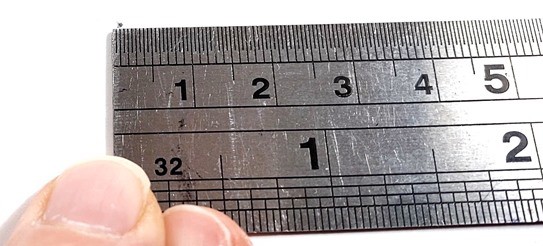 Image Credit: Svenja Lohner, Science Buddies / Science Buddies
Image Credit: Svenja Lohner, Science Buddies / Science Buddies
- An average pencil dot is about 1 millimeter (mm) in size (1 mm long and 1 mm wide). If your pencil dot has a different size, try to make another pencil dot that has a size of 1 mm. Then review the Units and Conversion Table again.How many 1-mm-sized pencil dots would fit on a 1-centimeter (cm) or 1-meter (m) pencil line?
- Viruses and bacteria are commonly measured in nanometers (nm) and micrometers (μm). Most known viruses have a diameter between 20 and 300 nm. The size of most bacteria, on the other hand, ranges from 0.2 to 2 μm in diameter.How many micrometers fit in 1 mm? How many nanometers fit in 1 mm?
- Next, you will make a scale model of a specific virus, the coronavirus Sars-Cov-2, which is 120 nm in size. A scale model allows you to understand the relative size of different objects. A toy car, for example is a scale model of a real car. It looks the same as a real car, but much smaller. You will start with a one-dimensional scale model, which means that you will only consider the length of the object. In your scale model, every object will become 10,000 times larger than it is in reality.How long is the 1 mm-sized pencil dot in your scale model (in meters)?
- Take the yarn and measure 10 m with your measuring tape, but be sure not to pull the yarn taut, as that will distort your measurements. Cut the yarn at 10 m. If you have the space, lay it out in one stretch or in a zigzag pattern. In your scale model, the length of this string of yarn represents the length of a pencil dot. Write a label that says "pencil dot" on a piece of paper and attach it to the string with tape.Now that the pencil dot has become 10 m long, how long do you think a virus would be in your scale model?
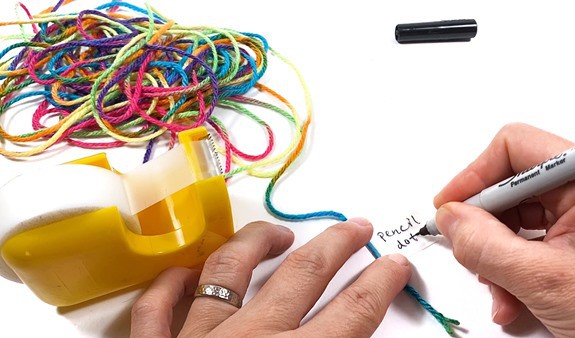 Image Credit: Svenja Lohner, Science Buddies / Science Buddies
Image Credit: Svenja Lohner, Science Buddies / Science Buddies
- Look at the Scaling Chart. It will give you the average real-life sizes of several objects, including microorganisms such as the Escherichia coli bacterium or the coronavirus. Remember that in your scale model the length and width of every object is enlarged by 10,000 times.
- Model the length of each of the objects highlighted in red on the Scaling Chart. In step 6 you already cut a 10 m long (or 10,000 mm long) piece of string that represents the 1-mm pencil dot in your scale model. Next, cut a piece of string that represents the diameter (or thickness) of a human hair. Label the piece of string so you know what it represents. For your model, assume an average hair diameter of 100 μm.How long does the piece of string need to be to represent a 100 μm-thick human hair?
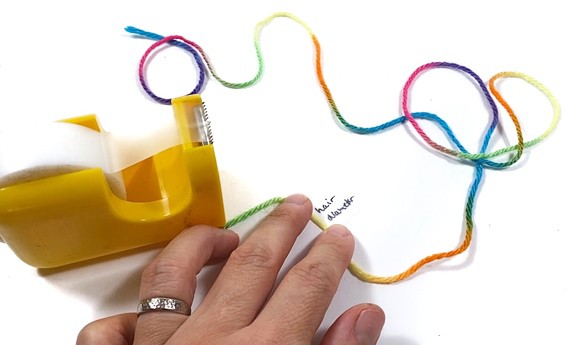 Image Credit: Svenja Lohner, Science Buddies / Science Buddies
Image Credit: Svenja Lohner, Science Buddies / Science Buddies
- Continue to model a mist water droplet that is 10 μm long. Cut a piece of string to the corresponding length and label it.How does the length of this string compare to the previous ones?
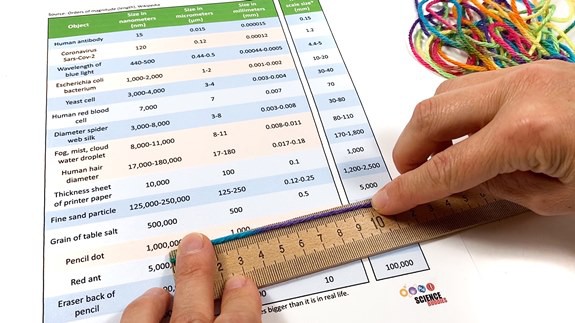 Image Credit: Svenja Lohner, Science Buddies / Science Buddies
Image Credit: Svenja Lohner, Science Buddies / Science Buddies
- The next piece of string represents an Escherichia coli bacterium that is 1 μm long. Such bacteria live in our gut and help digest the food we eat. Cut a piece of string to the corresponding length and label it.How long is an Escherichia coli cell in your scale model?
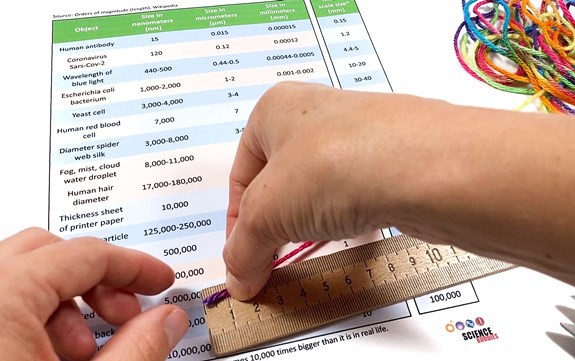 Image Credit: Svenja Lohner, Science Buddies / Science Buddies
Image Credit: Svenja Lohner, Science Buddies / Science Buddies
- Finally, model the coronavirus. Sars-Cov-2, which causes COVID-19, is about 120 nm long. Cut a piece of yarn that represents the length of the virus and label it.When looking at your model virus, remember that the coronavirus is only that big in your model where a pencil dot is 10 m long! In real life, it is 10,000 times shorter than this tiny piece of yarn!How big is the coronavirus in your model? Can you see it with your naked eyes?
 Image Credit: Svenja Lohner, Science Buddies / Science Buddies
Image Credit: Svenja Lohner, Science Buddies / Science Buddies
- Compare the lengths of the five different strings. If you have the space, lay out all five pieces of string next to each other. You can zigzag the 10-m yarn if you run out of space.What do you notice when comparing the lengths of all five strings? Does your model give you a better perception of how big or small the coronavirus is?
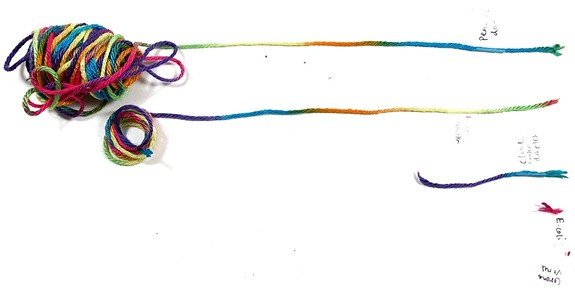 Image Credit: Svenja Lohner, Science Buddies / Science Buddies
Image Credit: Svenja Lohner, Science Buddies / Science Buddies
- Review the Scaling Chart again.Can you add other objects from the list to your scale model? How long would the piece of yarn be that represents the average length of a coffee bean?
Part 2 (Optional)
- Using a string to demonstrate the different sizes of objects allows you to model their sizes in one dimension only. In the next step, you will look at the sizes of objects in two dimensions (length and width). To reduce the complexity of the model, it is assumed that the objects have the same width and length—although this might not be true in reality. If you do not have enough space indoors, you can go outside into your driveway, yard, or to a park.
- Again, start with the biggest object in your model, the pencil dot. The string that represents the pencil dot should be 10 m long. Take the string to a place where you have lots of space, such as a park, your yard, or an empty parking lot. Use yarn or string to mark a square on the ground that is 10 m long and 10 m wide. In your scale model, this 10-m × 10-m square represents the size (length and width) of a pencil dot.
Note: You can skip this step and move on to the size of the hair in Part 2 step 3 if you do not have the space or prefer to stay indoors.Can you think of an object that has the size of this square in real life? - Take the next piece of string, which represents the average diameter of a human hair. If you made the 10-m × 10-m square, mark a new square inside the 10-m × 10-m square that is the size of a hair diameter in your scale model. If you did not lay out the 10-m × 10-m square, find a space where you can make a 1-m × 1-m square on the ground or wall and mark it with string, tape, or chalk (ask permission before marking or taping on the wall).Is the square big enough for you to stand in? How many of these squares do you think fit in the big square?
- Continue with the piece of string that represents the mist water droplet. Mark an area inside the 1-m × 1-m square that represents the water droplet.How much smaller is this square compared to the previous one?
- Next, mark a square that represents the Escherichia coli bacterium. Again, use the cut string from your model to make the square. If it is too difficult to mark the square with a string, cut a piece of paper that has the size of the E. coli bacterium in your model and place it inside the big square.How many of these bacterium cells do you think would fit into a mist water droplet?
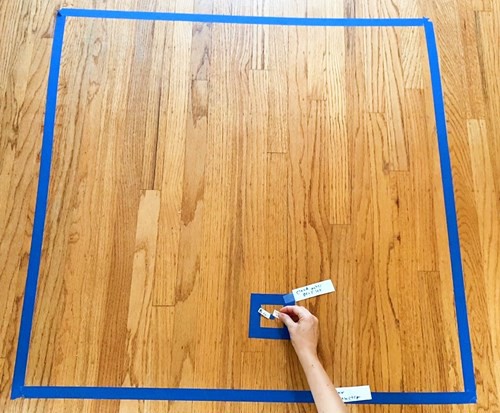 Image Credit: Svenja Lohner, Science Buddies / Science Buddies
Image Credit: Svenja Lohner, Science Buddies / Science Buddies
- Finally, make a pencil dot on a piece of paper and place it inside the big square. This pencil dot represents the coronavirus in your scale model. It is 1 square mm in size.How much smaller is the real coronavirus compared to the pencil dot in your scale model? How many coronaviruses could you fit inside a pencil dot?
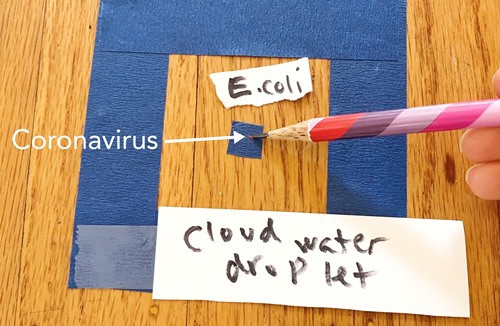 Image Credit: Svenja Lohner, Science Buddies / Science Buddies
Image Credit: Svenja Lohner, Science Buddies / Science Buddies
Cleanup
What Happened?
A virus, such as the coronavirus, is much too small to be visible with the naked eye; you cannot see them even with a light microscope! In order to make sense of the size of a virus, you built a scale model in this activity. In your one-dimensional scale model, a pencil dot, which is about 1 mm in length, became 10,000 times longer. This means that in your model, the string that represented the length of a pencil dot was 10 m long. When you modeled the other marked objects on the Scaling Chart (the hair diameter, mist water droplet, E. coli bacterium and the coronavirus), you probably noticed that the difference between their lengths was about one order of magnitude, which means that starting from the shortest object (the coronavirus), each following object was about 10 times longer than the previous one. As a result, in your model the pencil dot was 10,000 times longer than the coronavirus.
Based on that, the piece of yarn that represented the hair diameter in your scale model should have been 1 m long, the string for the mist water droplet 10 cm long, and the E. coli bacterium string 1 cm long. In your scale model, the coronavirus was 1 mm long, which is exactly the size of a pencil dot in real life. You probably noticed the differences in size even more in the two-dimensional scale model, which modeled the area of the different objects. In this model, the pencil dot should have been 10-m × 10-m, which equals 100 m2. In contrast, the coronavirus should have been 1 mm2. This means that in one pencil dot, you could fit about 10,000 × 10,000 (equals 100,000,000) coronaviruses!
Digging Deeper
Viruses are the cause for many infectious diseases, such as the flu or COVID-19. That is why it is important to protect yourself from exposure to these viruses in order to stay healthy. However, this can be difficult, as viruses are so tiny that they are not visible. In fact, most viruses are so small that you even cannot see them under a light microscope. Their size is in the nanometer range. The coronavirus Sars-Cov-2, which causes COVID-19, for example, has a size of about 120 nm (Figure 1). One nanometer (nm) is equal to one-billionth of a meter! That is shorter than the wavelength of visible light, which is in the range of 400–700 nanometers. Therefore, you need special instruments, such as electron microscopes, to make viruses visible. Because they are so tiny, health care providers have to wear special protective equipment, such as N95 masks, which are able to filter out such small particles.
 Image Credit: Svenja Lohner, Science Buddies / Science Buddies
Image Credit: Svenja Lohner, Science Buddies / Science Buddies
Figure 1. The size of a coronavirus particle is about 120 nanometers (nm).
Although we perceive viruses as very tiny, size is often relative, which means that in comparison to other objects a virus can be tiny or huge. For example, compared to atoms, which are 0.1–0.5 nm in diameter, a virus is pretty large. That is why we often compare the sizes of objects to get a better idea of how big or small they really are. A very useful tool for visualizing the size of objects is making a scale model. A scale model is a physical model of an object that is either larger or smaller than the actual size of the object. Such a model is specifically helpful for objects that are either too tiny to see, such as viruses, or too large to visualize, such as planets. An example of a scale model is a toy car or toy airplane. It looks exactly like a real car or airplane, but it is much smaller than a real one. For a scale model it is useful to know by how much the object is enlarged or shrunk compared to the real object. When you make a scale model of different objects at the same scale, you can compare their sizes, even though you might not able to see them in real life.
Measuring the size of an object can easily become complicated, depending on how many dimensions of the object you are considering (Figure 2). It is easy to measure the size of one-dimensional objects, such as a line or a piece of string, as these kinds of objects are usually measured in one dimension. The SI unit of measurement for length is meters (m). The SI measurement system is called the metric system, in which all measurements are related to each other by a multiple of ten. For example, 1 m is 100 times longer than 1 cm and 1000 times longer than 1 mm. Table 1 gives an overview of different measurement units for length and how they are related.
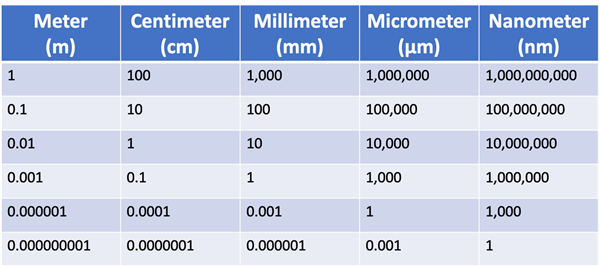 Image Credit: Svenja Lohner, Science Buddies / Science Buddies
Image Credit: Svenja Lohner, Science Buddies / Science Buddies
Table 1. Measurement units (SI) for length.
Size measurements become more complicated for two-dimensional objects, where you not only measure an object's length, but also its width. In this case, you are calculating an object's area. The units used for area are typically m2, or cm2 (pronounced square centimeters). A square that has sides that are 10 cm long, has an area of 10 cm × 10 cm = 100 cm2. To measure the total amount of space that a three-dimensional object occupies you would need to calculate its volume, which, in addition to its length and width, also includes an object's height. The volume of a three-dimensional rectangular object (a cube) is determined by multiplying its length, width, and height. The units of measurement for volume is usually m3 (pronounced cubic meters). For example, a cube that has sides that are 10 cm long, would have a volume of 10 cm × 10 cm × 10 cm = 1000 cm3.
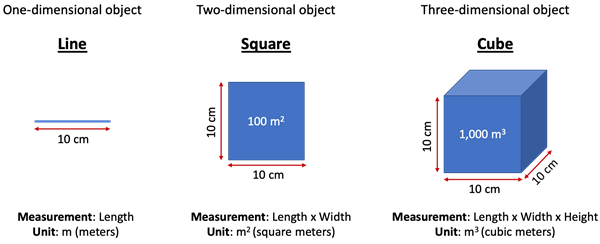 Image Credit: Svenja Lohner, Science Buddies / Science Buddies
Image Credit: Svenja Lohner, Science Buddies / Science Buddies
Figure 2. Measurement of one-, two-, and three-dimensional objects.
Ask an Expert
For Further Exploration
- Find other objects that would fit into your scale model. How big or small are they compared to the ones on the Scaling Chart?
- Can you find some real-life objects that are the size of your modeled objects? For example, the pencil dot in your scale model is 10 m long. What real-life objects do you know that are 10 m long?
- Can you find out how many viruses fit on a fingertip of about 1 cm2?
- What other objects can you model using a scale model? To make a scale model of our solar system, review Science Buddies' How Big Are the Planets in Our Solar System?.
- You can expand your virus scale model by one more dimension. Can you find materials to create three-dimensional models of all the objects on the Scaling Chart?


